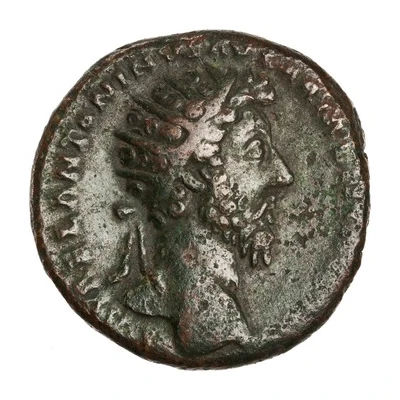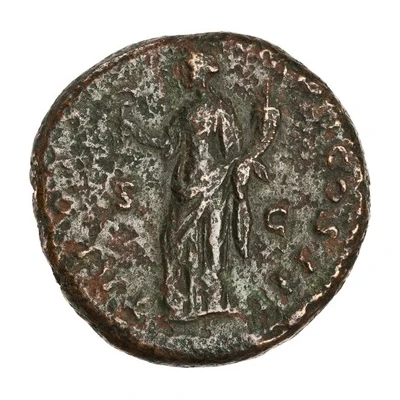Dupondius - Marcus Aurelius TR POT XIX IMP II COS III S C; Providentia
| Bronze | - | - |
| Issuer | Rome › Roman Empire (27 BC - 395 AD) |
|---|---|
| Emperor | Marcus Aurelius (Marcus Aurelius Antoninus) (161-180) |
| Type | Standard circulation coin |
| Years | 164-165 |
| Value | 1 Dupondius = ⅛ Denarius |
| Currency | Denarius, Reform of Augustus (27 BC – AD 215) |
| Composition | Bronze |
| Shape | Round (irregular) |
| Technique | Hammered |
| Demonetized | Yes |
| Updated | 2024-10-06 |
| Numista | N#263608 |
|---|---|
| Rarity index | 100% |
Reverse
Providentia, draped, standing left, pointing wand in right hand at globe at her feet and holding vertical sceptre in left hand.
Script: Latin
Lettering: TR POT XIX IMP II COS III S C
Translation:
Tribunicia Potestate Undevicesima, Imperator Secundum, Consul Tertium. Senatus Consultum.
Holder of tribunician power for the 19th time, supreme commander (Imperator) for the second time, consul for the third time. Decree of the senate.
Comment
Source:Online Coins of the Roman Empire (OCRE)
Interesting fact
The Dupondius coin was a bronze coin used in the Roman Empire during the reign of Marcus Aurelius (161-180 AD). It was introduced as a replacement for the earlier bronze coin, the As, and was valued at 2/3 of a denarius, the standard silver coin of the time. The Dupondius coin was widely used throughout the empire and was an important part of everyday commerce. One interesting fact about the Dupondius coin is that it features an image of the Roman goddess Providentia on the reverse side. Providentia was the goddess of foresight and was often depicted holding a scroll or a globe, symbolizing her ability to see into the future. The inclusion of Providentia on the coinage was a nod to the idea that the Roman Empire was guided by a higher power and that the emperor's rule was divinely ordained. Overall, the Dupondius coin is an interesting piece of history that provides insight into the economic and cultural practices of the Roman Empire during the 2nd century AD.

